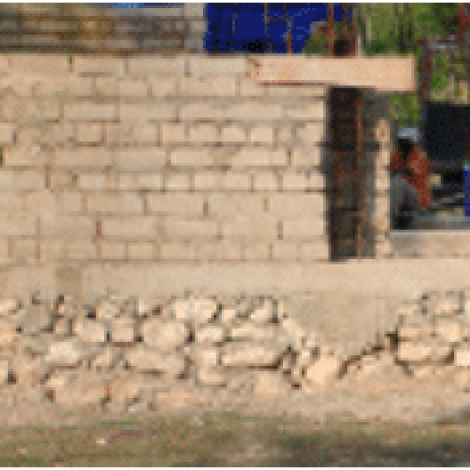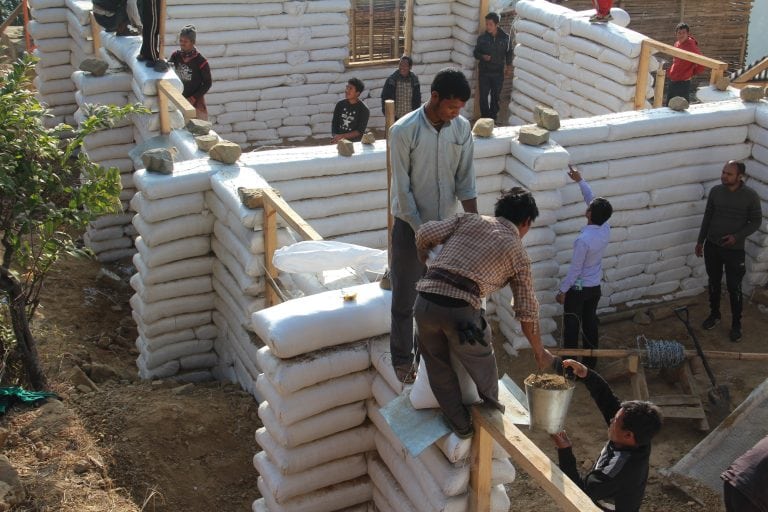A new kind of housing program delivers two things that Haitians need in their earthquake-prone neighborhoods: Affordable design and new construction techniques. Nearly five years after the earthquake flattened most of the nation’s capital, housing projects have run their course, homes are built and construction aid is dwindling. Now, many Haitians who want to build resort to cinder blocks, stacking them into the same kinds of structures that collapsed and left 1.3 million people homeless in 2010.
But it doesn’t have to be that way. A team called Engineering2Empower, composed of students and faculty at the University of Notre Dame in Notre Dame, Indiana, has introduced its first earthquake-resistant home to residents of Léogâne, the port town that was at the epicenter of the disaster. The team is now running a highly successful Indiegogo campaign to raise $50,000 to build a five houses in 2015. You can contribute at Indiegogo.

Photo courtesy of E2E
Housing Done Well
If there is a checklist for effective housing programs, E2E’s project marks all of the important boxes.
First, their design is strong. It’s a reinforced concrete frame walled in with lightweight prefab concrete panels.
Second, it makes sense to Haitians. The frame-and-panel design draws on the “gingerbread house” architecture that was popular in Haiti at the turn of last century. Many of those gingerbread houses still stood amid the rubble of collapsed cinder-block complexes after the earthquake. And E2E’s modified design is informed by field research. The team talked to Haitians who might live in a house like theirs and developed four models ranging in size from 250 to 775 square feet (23 to 72 square meters). And the house’s raw materials are all found locally in Haiti.
Third, E2E is helping future homeowners find financing to build their houses. Talks with a local bank are underway now.
And fourth, the organization is not building the homes themselves. Instead, they are working with local contractors. Paul Pierre Louis, a Haitian contractor and head of engineering at Magepa, S. A., who built E2E’s first prototype home, heaped praise on the design. It could change how construction is done in Haiti, he said.

Photo courtesy of E2E
“It makes construction a lot easier and the finish time a lot quicker. In Haiti, when we are building, the finishing time can represent 60 percent of the project. We could turn Haiti’s system into a Lego system where everything is prefabricated, planned, and any reasonably sized house could go up in less than a month,” Louis said. (Louis responded to our question through Dustin Mix, E2E’s director of operations in Haiti, who passed them onto E4C.)
We wanted to know more about the construction technique, so we asked Mix for details. Here are excerpts of his response.
Haiti’s mainstream construction problem
The dominant mode of construction for housing in Haiti is masonry. The reason that this type of construction failed so badly in the earthquake in 2010 boils down to three main issues:1. The block used was not strong enough nor did it have proper reinforcement. This lack of capacity to handle seismic forces, particularly shear forces, lead to brittle failures and subsequent transfer of forces to the intermediate concrete columns.
The concrete columns were undersized and under reinforced. Upon the transfer of forces from the block walls, the columns failed, eliminating all lateral capacity of the structure.
From a system level, there was no coherent lateral system. The small, under-reinforced columns were in most cases not properly tied together with a ring beam. And they were heavy because they had concrete slab roofs.
“Between reconnaissance work after the earthquake and a widespread survey effort, we were able to really wrap our heads around both the needs of the community, as well as the constraints in materials, skills, and demands on the structure” – Dustin Mix, E2E
E2E’s frame-and-panel solution
Our design looks to tackle all three issues. For starters, we decided to find a way to get rid of the cinder block. We settled on a precast, thin concrete panel that could be produced in Haiti as our wall system.
Once the frame is cast, these panels are attached with concrete anchors into the beams and then set into a mortared groove in the foundation. This frame-and-panel system is then topped with lightweight steel trusses, attached with hurricane straps, and metal roofing.
As you can see, we are able to address all the issues mentioned above. The block is replaced with a much lighter, nonstructural panel. The small, weak columns are replaced with an international-code-compliant reinforced concrete frame, that at the same time creates a coherent lateral system. And finally, it has a lightweight roof.
We did not have to do any experimental testing on the system from a structural perspective as the only real structural elements are the beams and columns of the frame. This system has been around for a long time, its seismic behavior is well understood, and international codes prescribe the processes for designing them for the specific seismic risk in Haiti.
As an earthquake occurs, the frame resists the majority of the forces. Even if the thin panels were to fail, there is little force transfer back to the frame, keeping the system as a whole intact. A homeowner could return and replace the panel afterward for a minimal cost, which will fall in the $50 to $100 range.
Standardized construction
The frame is the structural system of the entire house and it has to be sized and reinforced properly and its concrete must have sufficient compressive strength. We meet those goals with standardized, reusable formwork for our four housing models and a quality control process for mixing concrete.
[quote author=”Paul Pierre Louis, Magepa, S. A.”]We could turn Haiti’s system into a Lego system where everything is prefabricated, planned, and any reasonably sized house could go up in less than a month.[/quote]
Once erected, the formwork defines the sizes of the beams and columns without the need to measure each and every one. We have also created templates for the reinforcing steel cages that define the size of the cage and the spacing of the stirrups.
We have also been able to produce the panels in Haiti. A reinforcing mesh is placed in the panel for added strength and crack control and the concrete is mixed and controlled in the same fashion as the frame concrete.
Roof trusses and window and door inserts are all created off site and then brought to the home on the day of install. Because there is so much that is standardized and prefabricated off site, we believe that within the next year we will have construction time down to two to four weeks, depending on the model.
You can contribute to E2E’s campaign to raise $50,000 to build five homes at Indiegogo. And you’ll find more photos of the first model home build at E2E’s Facebook gallery


Looking to rebuild aN eaRthQUake damaGed school/church iN montrouis, haiti
How thin? From what i see it is simple post, beam and panel… no real change at all. Thin cast implies you are also using thin reinforcing elements, like wire in stucco. The key to casting thinly is supporting the wire inside the form, the key to reclaiming it’s economy is casting the height of the proposed wall ELIMINATING mid panel cold joints and thereby, patching.
If you are going to build a lighter concrete house, you are going to have to redesign the post from square to “T” or “L” (in plan view) and cast the panel monolithic with the post, as part of a post. This makes all of your wall “post”, so roof loading is spread further, reducing footing size.
You selected a metal roof, probably because you never lived under one before. I would suggest for your roof a 2″ thick concrete slab, if you do not know how to build one without shoring or false work, ask me.
I noted that many structures in Haiti used soft AGGREGATES (coral) with the obvious result of low compression value concrete. Just as an AIRPLANE made of lead will never fly, how did you estimate the structural value of your mix?
How long do the panels cure before they can be lifted into place? In our application they would have to be cast at the worksite where there is very limited flat space to cast more than one or maybe two at a time.
But how do you know for sure that they are EaRthQuAke proof?
Structures are tested in labs by placing them on a platform that moves like the ground might move in an earthquake. Also, just to nitpick here (sorry), they don’t call structures earthquake *proof* because nothing can withstand any size of earthquake. Meaning that there are earthquakes that could possibly damage or flatten any building ever constructed. Instead they say the structures are earthquake *resistant*. Hope that’s not too pedantic. Thanks for your interest.
is Haiti’s field stone foundation earthquake resistant or can it be reinforced to be more resistant in an earthquake?